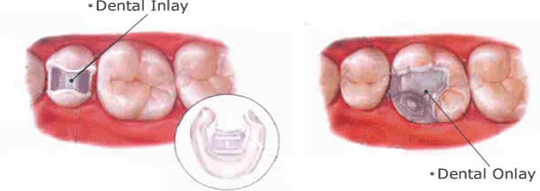
If you have recently been told you have tooth decay then you might have been expecting to have a filling as this is the most common way of repairing damaged teeth. But what if you have been told you need an inlay or onlay, and what are the differences between these three methods of repairing teeth?
Dental Fillings
Most people will have at least one or two fillings in their teeth, and these are used to repair small areas of decay. Modern fillings usually consist of a composite resin material that is tooth colored, and the advantage of this material is that it is designed to work in harmony with the natural tooth structure. This type of filling is easily completed in one visit, and can produce very good cosmetic results. Most composite resin fillings will last at least five years or more before they need replacing, and can be used to repair areas of decay and damage to both front and back teeth.
Inlays
Dental inlays are used to repair areas of decay in the chewing surfaces of the back teeth. Your dentist will recommend an inlay over a conventional dental filling if the area of decay is quite large. Repairing this area with a conventional filling would not provide sufficient strength and structure to the rest of the tooth, leaving it at risk of fracturing. Inlays are made from porcelain or gold, and help to hold the rest of the tooth together so that it can be used to bite and chew normally.
Onlays
Dental onlays repair not only the chewing surfaces of back teeth, but also one or more of the cusps. The cusps are the raised points of the tooth located on the outer edges. They are used when the decay is more substantial, but when there’s still enough of the original tooth structure remaining to make crowning the tooth unnecessary. Onlays can be made from porcelain or gold.
Techniques for Making Inlays and Onlays
Inlays and onlays are sometimes called indirect fillings, and the reason for this is that they would normally require more than one visit to the Cosmetic Dentistry Center. This will still be the case if you opt for gold inlays or onlays, as they have to be made on-site in our dental laboratory. Your tooth will be prepared before an impression is taken and sent to our laboratory for your gold inlay or onlay to be custom-made. However porcelain restorations can quite possibly be made while you wait using our CEREC machine.
CEREC
This is where the restoration is milled from a single block of porcelain before being polished and finished so it can be permanently cemented in position by your dentist. This is an extremely good technique that produces a very strong and durable restoration, restoring the tooth to full function. Another advantage of using this type of restoration is that it doesn’t require any dental impressions to be taken. Some people find it quite difficult to have an impression taken, particularly if they have a strong gag reflex.
CEREC restorations are constructed through your dentist scanning your tooth with a small infrared camera after which the information is sent to a computer so the restoration can be designed. This information is then sent to the milling machine for the restoration to be fabricated. We always keep a large range of different shades of porcelain blocks on-site, and our dentists can select the shade closest to your natural teeth.
You can rest assured that whichever method is used to repair your teeth it will be the best way of restoring it to full strength and of protecting the remaining tooth structure.
#FillingsVsInlaysVsOnlays
Leave a reply →





